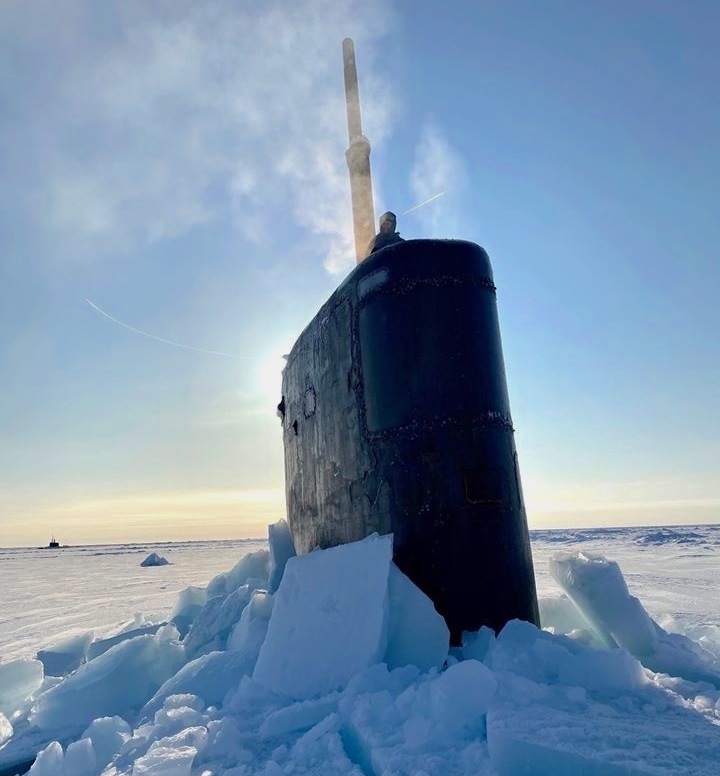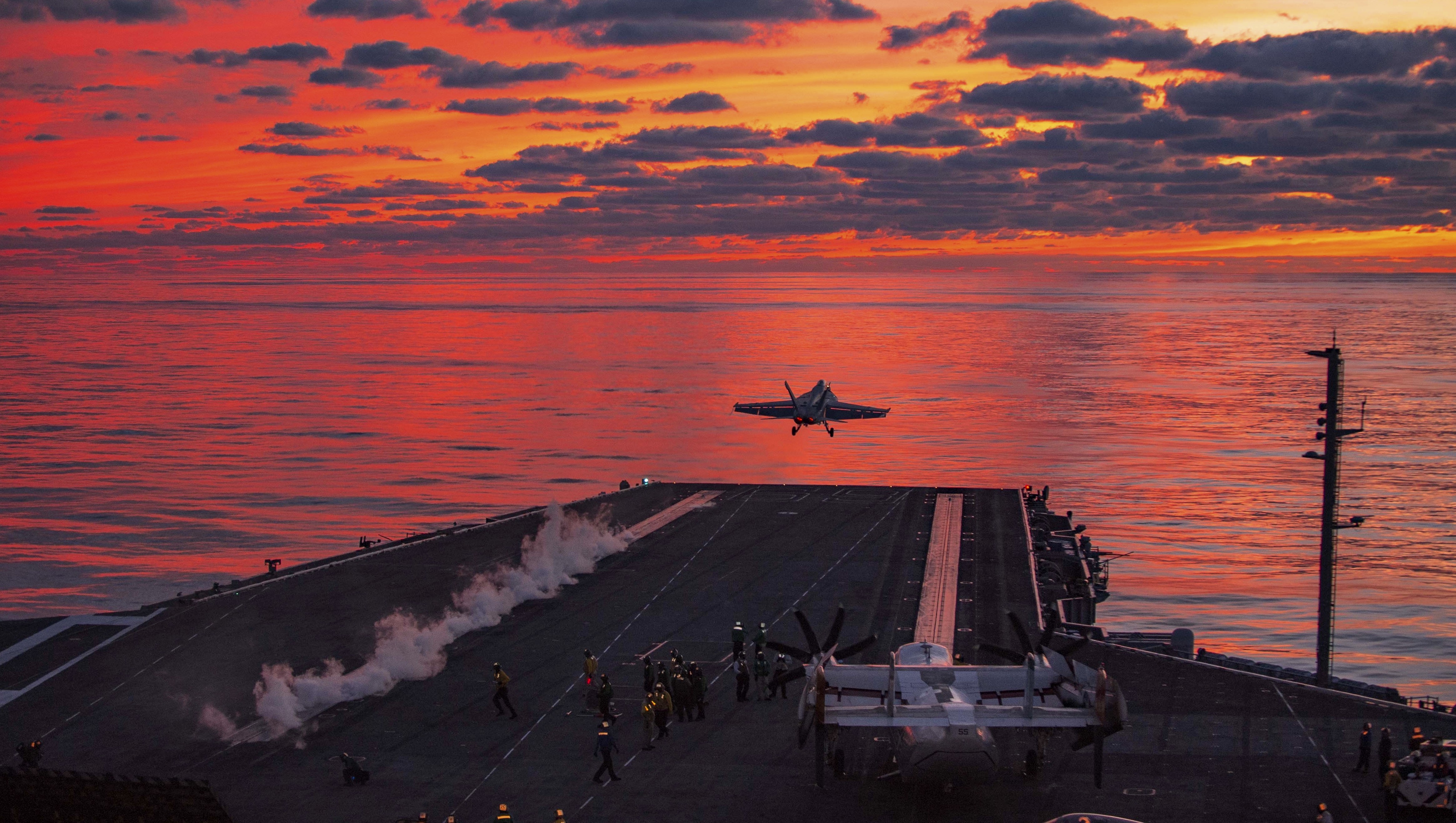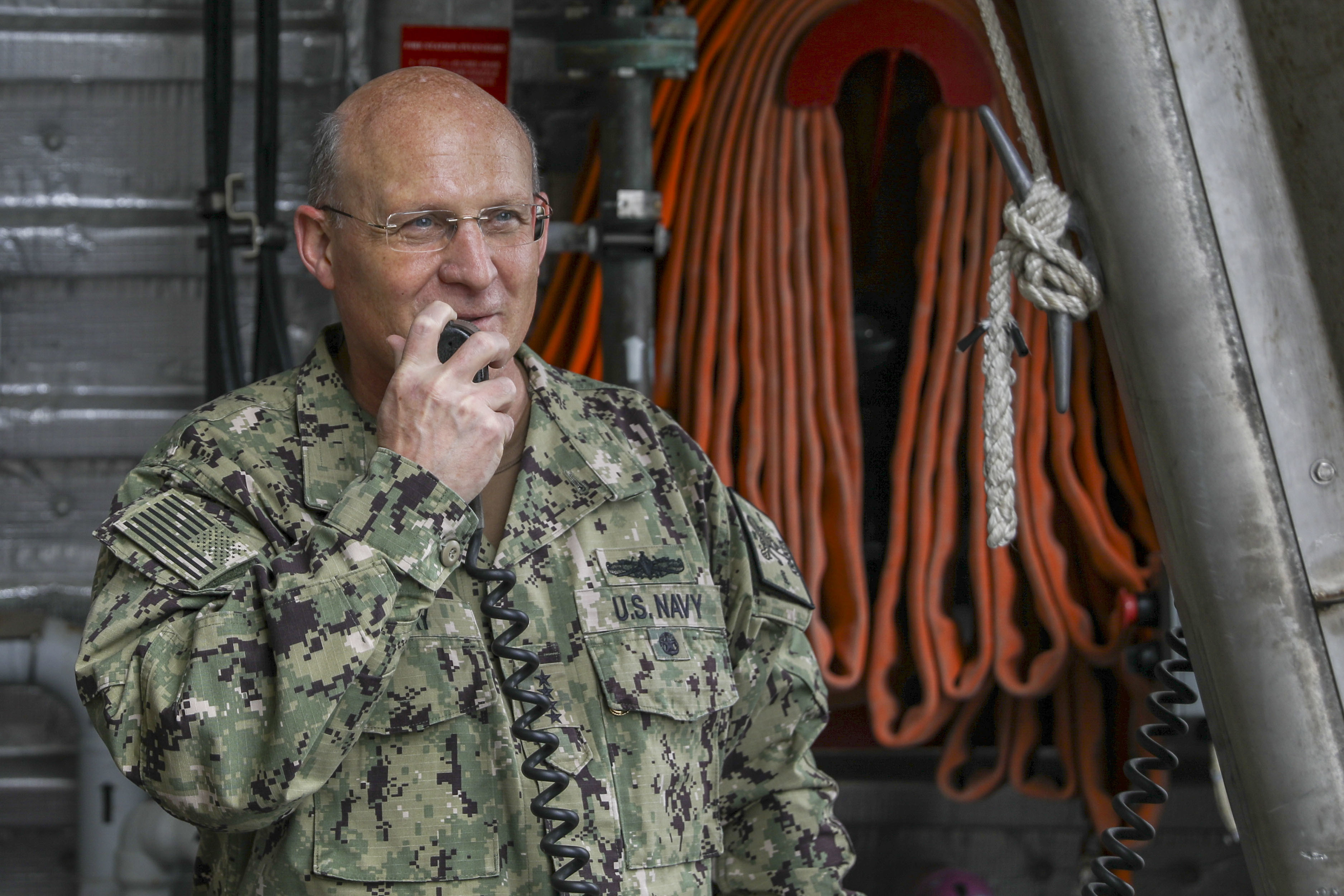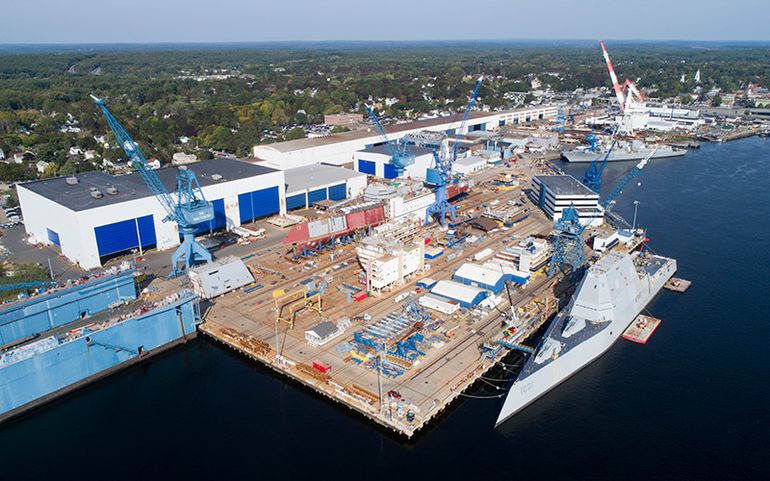
The chief of naval operations said an ongoing Global Force Posture Review led by the defense secretary could bring about changes to how aircraft carriers and other in-demand naval assets should be deployed around the world in the future, as one deployed carrier strike group that trained for a range of new missions is now in the Middle East conducting the same old missions of land strikes and deterrence against aggression from Iran.
For years, the Navy has talked about deploying its aircraft carriers more dynamically, focusing on peer or near-peer adversaries like China and Russia and keeping them on their toes as to when an aircraft carrier might pass through certain regions to operate or train with regional partners. Though the Navy creates that strategy and trains deploying forces for those new scenarios, it is the Joint Force that actually employs ready carriers – and the Joint Force continues to send a steady stream of carriers to U.S. 5th Fleet, where they often patrol a small box in the Persian Gulf or just outside it.
In January and February, the Dwight D. Eisenhower Carrier Strike Group conducted a pre-deployment training event that included the Navy and Marines’ newest island-hopping tactics under the Expeditionary Advance Base Operations concept, and it rehearsed a NATO scenario to ensure the unit could quickly fall under NATO command and control procedures, as well as patch into the NATO communication infrastructure, if it had to quickly support operations in U.S. 2nd Fleet or U.S. 6th Fleet.
Still, the IKE CSG on Friday passed through the Suez Canal and into 5th Fleet in U.S. Central Command for patrols there.
Chief of Naval Operations Adm. Mike Gilday told USNI News today during a Defense Writers Group online event that Defense Secretary Lloyd Austin had kicked off a Global Force Posture Review that would either validate the need to have a regular carrier presence in the Middle East or could lead to changes in how the Joint Force employs naval forces. The mismatch today, he said, is between the National Defense Strategy as it’s written – which supports a naval force that preserves its readiness and trains for high-end operations, rather than expending all ready forces on routine missions against lower-level threats – and the NDS as it’s being implemented.

“During the secretary of defense’s confirmation hearing, there were two things that stood out for me with respect to the NDS: one is that he wanted to do his own assessment to see if all the elements of the NDS were still applicable – in other words, did he have to change anything in the NDS? And the second thing, and I think it kind of gets to your point, are we resourcing the day-to-day posture of the globe in the right way? Are we implementing the NDS in the manner that it was supposed to be implemented?” Gilday said.
“I think that the global posture review will help give us a better understanding of where we stand right now to answer the secretary’s questions about implementation of the NDS and whether any changes are required, and I think that ought to drive our use of not only aircraft carriers but the entire joint force. Carriers are of course an important element of that” and among the most sought after by combatant commanders, he added.
As for CENTCOM specifically, Gilday said it “is a maritime AOR; the real question is, how much carrier presence is required in the AOR on a sustained basis – in any AOR.”
Gilday said the review could have other implications for the Navy, too. Former Navy Secretary Kenneth Braithwaite proposed several changes, including re-activating U.S. 1st Fleet to reduce the workload in the Indo-Pacific on U.S. 7th Fleet, and renaming U.S. Fleet Forces Command as U.S. Atlantic Fleet. Gilday said both efforts are on hold, pending Austin’s force posture review.
“When that’s finished later on this summer, we should have a better sense of what direction we’re going to go in, or not, with respect to fleet organization,” he said.
When the Navy first pitched its “dynamic force employment” concept to be tactically unpredictable during deployments, the service sent the Harry S. Truman CSG up into the Arctic for the first time in about 30 years.
Gilday said he thinks that, since then, the Navy has succeeded in making Arctic presence more routine instead of a novelty operation – with more than 20 exercises or operations there in the past year alone – but the force posture review could have implications for operating above the Arctic Circle as well.

“Our presence in the Arctic is no longer rare; it’s becoming part and parcel of what we do, particularly I would say in the EUCOM AOR. But, as part of this global posture review, one of the areas that I think we need to look at as an Arctic nation is that area that, essentially you have three combatant command commanders who bound the Arctic (EUCOM, INDO-PACOM and U.S. Northern Command), and so as a force provider, as the CNO, I’m providing forces that the secretary of defense ultimately decides in a prioritized fashion how to allocate those and use those across the combatant commands. And I think we may have a better sense coming out of the posture review on how we may operate even more robustly up north,” Gilday said during the event.
Gilday was also asked about the upcoming Fiscal Year 2022 budget request, which is still being worked inside the Pentagon.
In the waning weeks of the Trump administration, the Navy appeared to be on track to get a larger percentage of the overall defense budget, after the Office of the Secretary of Defense and its Cost Assessment and Program Evaluation office conducted a Future Naval Force Study assessment last year and found the Navy needed to aggressively pursue a larger force and a more lethal force – with unmanned systems and new weapons to counter China and Russia – to keep the U.S. competitive globally.
Under the Biden administration, it’s still unclear how much money the Pentagon will have to spend in 2022, let alone how that could be divvied up among the services.
“I have no idea what that topline’s going to be right now,” Gilday said.
“I wouldn’t be able to speculate. I can tell you though that I think the Navy is in a really strong position right now to continue to argue for a bigger, better Navy based on, grounded on the Future Naval Force Structure Assessment done under the previous secretary of defense in 2020.”
Gilday said one of the strengths of the FNFS effort was that it didn’t just look at the overall number of ships the Navy needed but rather considered things like “combat lethality, survivability, operational reach,” as well as total ownership cost, maintenance requirements, technical risk of developing new systems, industrial base capacity to build them and more.
Though the plan assumed the Navy would see 2.1 percent growth for inflation plus 2 percent real growth in its budget, Gilday said the plan was a “realistic, candid, frank shipbuilding plan” based on “sound analysis.”
“Using that analysis is kind of our beginning argument because OSD CAPE played such a key role in generating that analysis to begin with, and those analysts are still in those seats at OSD, and so we’re continuing to use that kind of as our basis” during the ongoing budget negotiations within the Pentagon.

Gilday said he hadn’t spoken to the other service chiefs about how a larger Navy budget would affect the Army or Air Force, for example, but “with this administration, I’m really resting our presentation of what we think we need based on the merits of the case largely grounded in that analysis” from last year’s FNFS.
“This wasn’t just Navy self-speak, where the Navy did the analysis on its own to come up with a composition of the future fleet and included a range of numbers for different types of platforms,” he later said to another question.
“This was an effort that fell under the secretary of defense, where you had analysts from OSD CAPE, you had analysis from the Navy and you had analysis from the Marine Corps, all came together – including a very robust red cell that was led by OSD and also a group of outside experts from think tanks, from industry, from academia, previous service members, that formed a group that advised the secretary of defense and kind of performed their own red team function on the rigor of the analysis that was done. So the Future Naval Force Assessment, in my view, that’s the requirements document, but it isn’t based on a pie-in-the-sky number, it’s actually grounded on analysis.”
In short, he said, “I think that the FNFS has very clearly allowed us to see what the composition of the future fleet has to look like in order to not only compete but to beat the Chinese.”
During the virtual event, Gilday was also asked about the recent release of a Marine Corps investigation into last summer’s sinking of an amphibious assault vehicle in waters off the coast of California. Though the Marine Corps operates the AAVs and led the investigation, the AAVs were training with amphibious transport dock USS Somerset (LPD-25) ahead of a combined Navy Amphibious Ready Group (ARG) and Marine Expeditionary Unit (MEU) deployment.
Gilday said he met with Commandant of the Marine Corps Gen. David Berger after the investigation to discuss “gaps and seams” between Marine Corps and Navy operations and protocols that shouldn’t exist – including safety measures during training events that played a role in the nine deaths that resulted from the AAV mishap.
Gilday said they agreed to standardize AAV operations instructions between the two services and also to take a broader look at all tactical operations that the two perform together to ensure there are no discrepancies in how the services train, operate and ensure safety during combined Navy/Marine Corps events.





